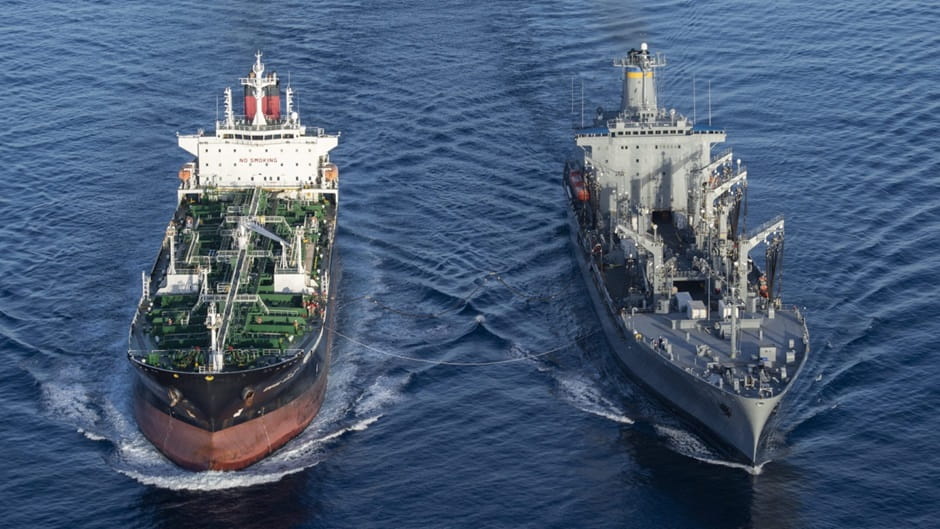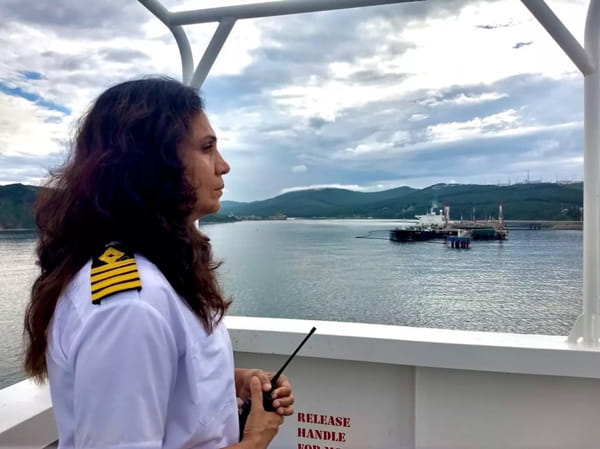
Indian Navy warship escorting a merchant vessel | gcaptain.com
The Indo-Pacific region faces significant maritime security challenges due to natural disasters, criminal activities, and interstate tensions, leading to loss of life and threats to regional stability. A proposed solution is establishing an Indo-Pacific Center of Excellence (COE) for Maritime Governance to address maritime security issues. This COE would help improve maritime safety and security by providing skills training, research, capacity-building coordination, best practices development, and fostering regional cooperation.
In April 2024, Admiral DK Tripathi assumed office as India's 26th Chief of the Naval Staff. This article encourages the Admiral to take input from the deck plate to lead the way toward meeting objectives. An area of improvement includes the role of Merchant Mariners.
India’s Merchant Mariners: A Vital Component of the Nation’s Maritime Defense
Merchant Marines tend to get step treatment as they are not a government agency or military service in most countries. The full-scale coordination between the Indian Navy, Merchant Mariners, and the Coast Guard is a vital component of the nation's maritime defense. India is the third-largest supplier of sailors to the global shipping industry, after China and the Philippines, providing roughly 7% of the world's Merchant Mariners.
As of March 2024, estimates suggest India has around 250,000 seafarers, with 160,000 working on cargo ships and 90,000 on cruise liners.1 This number has grown by about 270% over the past decade, and industry experts predict that India's share of global seafarers could increase to 20% over the next decade. India’s Navy Merchant Mariners play a crucial role in ensuring the smooth operation and co-ordination between the nation’s merchant fleet and its naval service. Merchant Mariners link the commercial shipping industry to the Indian Navy, providing essential support in times of national security and emergencies.
The Merchant Mariners of India are trained professionals who operate merchant vessels that transport goods and commodities across the seas. While their primary responsibility is to ensure the safe and efficient transportation of cargo, they also play a crucial role in supporting the Indian Navy in times of need.

India’s first female Merchant Navy captain, Captain Radhika Menon. | International Women Seafarers Association.
Merchant Mariners are often called upon to assist the Navy in times of war or national emergencies. They may be tasked with transporting military personnel, equipment or supplies to areas of conflict or disaster. In such situations, Merchant Mariners must work closely with the Navy to ensure the safe and timely delivery of goods and services.
India has a merchant fleet of nearly 1,500 seagoing ships with a total capacity of 13 million gross tonnes (GT), accounting for about 1.3% of the world's total deadweight tonnage.2 However, about 36% of India's merchant fleet is flagged outside of the country, which is a geopolitical imbalance. For example, India's growing imports and exports are carried on foreign-owned ships.3 In a war-like situation, India would have to consider the reliability of its home-owned ships to transport energy and food supplies.
Coordination between the Merchant Mariners and the Navy is essential for the success of any operation. The two entities must work together seamlessly to ensure that missions are carried out effectively and efficiently. This requires open communication, mutual respect and a willingness to extensively and rigorously collaborate for the greater good of confluent operations using advanced digital methods in places such as the Red Sea. Notably, due to the rise of digitization and automation in the maritime industry, ships are increasingly interconnected and reliant on technology. This has opened up new vulnerabilities to cyberattacks, which can have devastating consequences for both the crew's safety and the vessel's security. Cyberattacks on ships can range from hacking into the ship’s systems and causing physical damage to stealing sensitive information and disrupting operations.
In order to prevent and mitigate these risks, it is essential for India’s global seafarers to receive cybersecurity training. This training should cover a range of topics, including how to recognize and respond to cyber threats, how to safeguard sensitive information, and how to secure onboard systems and networks. Seafarers should also be trained on how to properly use and maintain the technology onboard the vessel, as well as how to identify and report any suspicious activity.
In addition to their roles in national defense and emergencies, Merchant Mariners also play a vital role in supporting the economy and international trade. The shipping industry is a key driver of economic growth in India, and Merchant Mariners are at the forefront of ensuring the smooth flow of goods and services across the oceans.
India’s Navy Merchant Mariners are an essential component of the nation’s maritime defense and economic prosperity. They play a critical role in coordinating with the Indian Navy to ensure the safety and security of the seas and support the nation's economy through international trade. Their dedication, professionalism, and commitment to serving the Nation is commendable, and they deserve recognition for their essential contributions to India's maritime industry.
Non-traditional Grey-zone Tactics
The conflict in Yemen, which has been ongoing since 2014, has had far-reaching consequences beyond the country's borders. One of the most concerning developments in the conflict has been the use of non-traditional maritime grey-zone tactics by the Houthi rebels in the Red Sea. These tactics have significantly impacted maritime trade routes and the security of countries in the region, including India.
Grey-zone tactics refer to the use of unconventional and ambiguous methods to achieve strategic objectives. In the case of the Houthis in the Red Sea, these tactics have included the use of asymmetric warfare, such as mines and other explosive devices, to target commercial vessels and disrupt maritime traffic. Additionally, the Houthis have also engaged in illicit activities such as smuggling and piracy to fund their operations and further destabilize the region.
Admiral Tripathi must consider the impact of these non-traditional maritime tactics on India. As a significant player in global trade, India relies heavily on the maritime routes passing through the Red Sea to transport goods and energy resources. Any disruption to these routes can have serious economic consequences for India and other countries that rely on the free flow of maritime trade in the region.
As recently as March 2024, India brought 35 captured Somali pirates to Mumbai to stand trial for hijacking the cargo vessel MV Ruen in December. This marks the first time in over a decade that pirates captured at sea will be brought to Indian shores to face trial. The Somalis will be prosecuted under India's anti-piracy laws, facing potential death sentences if convicted of killing or attempted killing, and life imprisonment for piracy. The Navy's intensified anti-piracy efforts have resulted in significant success, with the rescue of the MV Ruen and its crew, as well as the capture of the pirates.
These pirates are suspected of being involved in the hijacking of the bulk carrier MV Abdullah, highlighting the ongoing threat of piracy in the region. The Indian Navy's deployment and operations have been crucial in combating piracy and maritime assaults in the Arabian Sea and the Gulf of Aden. It was noted that, at the peak of their attacks in 2011, Somali pirates cost the global economy an estimated $7 billion in ransom payments.4
Furthermore, the instability caused by the Houthi tactics in the Red Sea has also raised security concerns for India. The possibility of attacks on commercial vessels carrying Indian goods or personnel is a real threat that must be taken seriously. The need for increased maritime security measures in the region is now more urgent than ever, as the risk of further escalation of conflict and violence remains high.
The non-traditional maritime grey-zone tactics used by the Houthi rebels in the Red Sea have significantly impacted maritime trade routes and security in the region, including India. It is imperative that the international community take steps to address these tactics and ensure the safety and security of the maritime routes in the Red Sea. Failure to do so may have dire consequences for the global economy and the stability of the region as a whole.
In comparison, China's Maritime Militia, for example, has been a source of concern for many countries in the region, especially as its size and capabilities continue to grow. The Maritime Militia is a paramilitary force that operates alongside the Chinese Navy and Coast Guard, carrying out a range of missions from maritime surveillance to assisting in territorial disputes. With an estimated size of around 190,000 personnel, the Maritime Militia is one of the largest paramilitary forces in the world.
One of the key areas of concern regarding China’s Maritime Militia is its impact on maritime channels, particularly in the South China Sea. China’s militia has been accused of engaging in aggressive tactics to assert Chinese territorial claims in the region, including ramming foreign vessels and harassing fishermen from neighboring countries. This has led to tensions with Vietnam, the Philippines, and Malaysia, who also have claims in the South China Sea.
The presence of China's Maritime Militia has also impacted India's maritime industry. Like many other countries in the region, India relies heavily on maritime channels for trade and commerce. The aggressive actions of the Maritime Militia have raised concerns about the safety and security of these channels, leading to increased patrols and security measures by the Indian Navy.
In response to the growing threat posed by China’s Maritime Militia, countries in the region have called for greater cooperation and coordination to ensure the stability and security of maritime channels. The United States has also stepped up its presence in the region, conducting freedom of navigation operations to challenge China’s territorial claims and assert the rights of all countries to navigate freely in international waters.
As China’s Maritime Militia continues to grow in size and capabilities, it is clear that it will remain a significant factor in regional maritime security. It is essential for countries in the region to work together to address this threat and ensure the safety and security of maritime channels for all. Only through cooperation and coordination can we hope to effectively counter the growing influence of China’s Maritime Militia and uphold the principles of freedom of navigation and international law in the region.
Indo-Pacific Center of Excellence (COE) for Maritime Governance
The Indo-Pacific region faces significant maritime security challenges due to natural disasters, criminal activities and interstate tensions, leading to loss of life and threats to regional stability. A proposed solution is establishing an Indo-Pacific Center of Excellence (COE) for Maritime Governance to address maritime security issues primarily caused by governance insufficiency.5 This COE would help improve maritime safety and security by providing skills training, research, capacity-building coordination, best practices development, and fostering regional cooperation.
(Exclusive to NatStrat)
Endnotes: